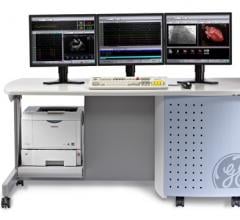Geneva Healthcare will showcase a set of new features on The Geneva Healthcare Suite – a technology platform for managing data from cardiac devices – at Heart Rhythm Society's annual scientific sessions in Boston. The cloud-based software suite organizes device data from multiple sources on an intuitive dashboard to provide critical health information to clinicians in real time. New features in The Geneva Healthcare Suite 2.0 focus on streamlining practice workflow and patient engagement with automated reminders, notifications and follow-up for remote monitoring that create an open channel of communication between doctor and patient.
St. Jude Medical Inc. announced CE Mark approval of expanded labeling for its Ellipse implantable cardioverter defibrillator (ICD), in addition to its Durata and Optisure defibrillation leads. The approvals allow existing or future patients with these technologies to undergo magnetic resonance imaging (MRI) scans without compromising device performance. The company also announced that it has received CE Mark approval for its Assurity MRI and Endurity MRI pacemaker device families. The approvals further expand St. Jude Medical’s MRI-conditional device portfolio in Europe.
Accreditation for Cardiovascular Excellence (ACE) has just released the first-ever electrophysiology (EP) and implantable cardioverter defibrillator (ICD) standards for accreditation. Driven by the latest available clinical evidence, the EP and ICD standards are a comprehensive review of interventional procedures in patients and adults with heart rhythm disorders.
Cardiac PET/CT represents a major advancement in cardiovascular diagnostics, offering significant clinical and ...
A new study reports that antiplatelet drug ticagrelor (Brilinta) works faster and is more effective in blocking platelet activity in low-risk patients with acute coronary syndrome (ACS) than clopidogrel. The study was presented as a late-breaking clinical trial at the Society for Cardiovascular Angiography and Interventions (SCAI) 2015 Scientific Sessions in San Diego.
Combining statins for low-density lipoprotein (LDL) and calcium channel antagonists for blood pressure reduces harmful coronary plaque, according to a study presented at the Society of Cardiovascular Angiography and Interventions (SCAI) 2015 Scientific Sessions in San Diego. The study, presented as a late-breaking clinical trial, found aggressive medication therapy does not provide additional benefit compared to standard cholesterol and blood pressure-lowering therapy.

A white paper published by the Heart Rhythm Society (HRS) and National Stroke Association characterizes the impact of stroke on patients with atrial fibrillation (AF) and presents common barriers to effective communication among patients, caregivers, and physicians. The white paper, Impact of Stroke in Atrial Fibrillation, is a collaborative effort between the two organizations to improve education and diminish stroke risk in patients with AF.
SPONSORED CONTENT — Studycast is a comprehensive imaging workflow system that allows healthcare professionals to work ...
ScImage announced that it has received validation for its PICOM365 enterprise picture archiving and communication system (PACS) within the framework of the Veterans Health Administration (VHA) system. The solution was validated as “Supported for HL7 Communication” with VHA’s VistA Imaging system.
A new independent evaluation report from the Department of Health and Human Services showed that the Pioneer Accountable Care Organization (ACO) payment model has generated substantial savings to Medicare in just two years. Additionally, the independent Office of the Actuary in the Centers for Medicare & Medicaid Services (CMS) has certified that this patient care model is the first to meet the stringent criteria for expansion to a larger population of Medicare beneficiaries.
Pressure to create alternative payment models has led to a significant increase in provider interest in partnering with Premier Inc. to develop and implement population health management strategies.
Providing exceptional cardiovascular care for patients to achieve the best possible outcomes is the number one goal for ...

Most community hospitals with cardiac catheterization labs share these facilities with multiple, non-interventional cardiology users, which can be challenging to manage various specialties’ needs. Beyond percutaneous coronary interventions (PCI), these labs are frequently shared with electrophysiologists (EP), vascular surgeons conducting endovascular repairs and interventional radiologists (IR) performing an array of non-coronary vascular or peripheral interventions.
Fujifilm Medical Systems U.S.A. said it completed its acquisition of TeraMedica Inc., a global healthcare informatics company and a provider of vendor neutral, enterprise solutions. The acquisition will allow Fujifilm to offer the market a leading vendor neutral archiving (VNA) technology.
At Nebraska Medicine, technology innovations bring with them opportunities to enhance patient care. The ability to integrate patient images with synchronized and simultaneous audio and video has Nebraska Medicine’s telehealth coordinator Kyle Hall looking at new ways to implement telehealth and mobile devices, such as iPads and Google Glass, at clinics and hospitals.
Cardiac positron emission tomography (PET) is growing in popularity among cardiologists because it provides the ability ...
Abbott and GE Healthcare announced an agreement that will bring real-time, patient-specific data about the heart's electrical activity to cardiac electrophysiology labs. The goal of the collaboration is to speed up the diagnosis of the sources of atrial fibrillation and other heart rhythm disorders.
For the first time, cardiac catheterization laboratory stakeholders now have quality metrics that confirm the value of Accreditation for Cardiovascular Excellence (ACE) accreditation. Three new studies validating the benefits of ACE accreditation were presented during the 2015 Society for Cardiovascular Angiography and Interventions (SCAI) Scientific Sessions in San Diego, California, May 6-9.
A team from Stanford University School of Medicine has developed and combined new paper and flexible polymer substrates with special sensing devices for rapid and accurate detection of pathogens such as HIV and other biotargets. These novel technologies offer the type of robust, simple, and inexpensive biosensing systems required to provide point-of-care healthcare in remote areas, where there is minimal diagnostic infrastructure or equipment and a lack of trained medical technicians.


 May 15, 2015
May 15, 2015












